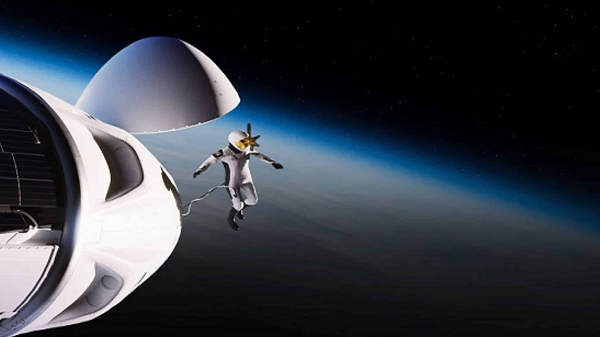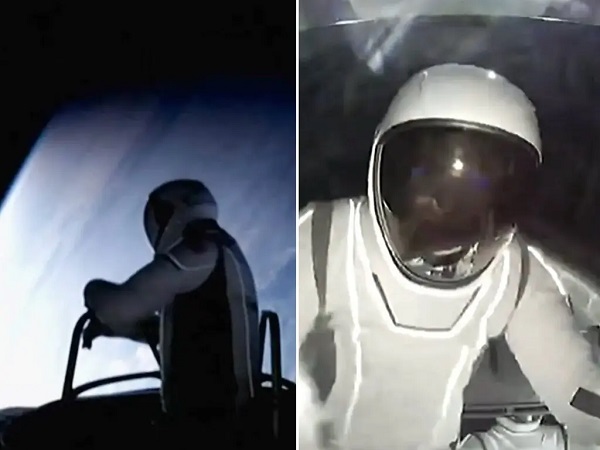Ad Blocker Detected
Our website is made possible by displaying online advertisements to our visitors. Please consider supporting us by disabling your ad blocker.
A new milestone is reached with the first private spacewalk in the SpaceX capsule
A new milestone is reached with the first private spacewalk in the SpaceX capsule, In an experiment testing commercial space capabilities, SpaceX engineer Sarah Gillis and billionaire Jared Isaacman, who is spearheading the Polaris Dawn mission, left and returned their ship.

Early on Thursday morning, two private astronauts conducted the first-ever commercial spacewalk by stepping outside their ship.
Polaris Dawn is a joint venture between SpaceX, led by billionaire Jared Isaacman, and Elon Musk. The spacewalk served as the mission’s focal point.
A new milestone is reached with the first private spacewalk in the SpaceX capsule
“From this vantage point, Earth appears to be an ideal world, even though we all have a lot of work ahead of us back home,” he remarked, standing in the SpaceX Crew Dragon capsule’s hatch with the planet overhead.
The successful operation serves as more evidence that space travel and spacewalks, when humans are merely shielded from airless death by their spacesuits, are no longer the sole domain of professional astronauts employed by governmental space agencies like NASA. The first of three Polaris missions, this one aims to speed up technological advancements necessary to realize Elon Musk’s dream of sending humans to Mars in the future.

NASA Administrator Bill Nelson applauded the spacewalk, in which the government space agency was almost absent.
On the website X, Mr. Nelson wrote, “Today’s success represents a giant leap forward for the commercial space industry and NASA’s long-term goal to build a vibrant U.S. space economy.”
Also Read: The AirPods Pro 2 will serve as hearing aids
At 6:12 a.m. Eastern time, the astronauts’ spacesuits were filled with oxygen, signaling the official start of the spacewalk. Even though it was over three hours later than anticipated, the procedure went down without a hitch.
Because there is no airlock in the SpaceX Crew Dragon spacecraft used for the flight, the only way to perform a spacewalk is to let all of the air out of the spacecraft. NASA and Soviet astronauts conducted spacewalks in a similar manner in the 1960s. A new milestone is reached.
First turning a hand crank, Mr. Isaacman opened the top hatch of the capsule and moved outside, where he conducted mobility tests of his spacesuit.
His stay in the vacuum of space was brief for a journey that had previously taken humans to the highest orbit in over fifty years: Mr. Isaacman returned to the capsule after a few minutes, and SpaceX engineer Sarah Gillis moved outside to carry out the same mobility tests.
The other two crew members, Scott Poteet and Anna Menon, were also wearing spacesuits inside the airless capsule, even though they stayed inside the vehicle. Four astronauts were subjected to space vacuum at the same time for the first time.
After Ms. Gillis re-entered, she closed the hatch, and the inside of the spacecraft was slowly repressurized. Less than two hours after it started, the spacewalk was over.
A key goal of the Polaris Dawn mission is the development of more advanced spacesuits that would be needed for any attempt at off-world colonization by SpaceX. During a news conference before the launch, Mr. Isaacman mused about how someone stepping onto Mars might one day wear a future version of the spacesuit that SpaceX developed for this mission.
Also Read: Microsoft 365 Outage
Commercial spacewalks may make previously unthinkable opportunities closer to Earth viable, such as allowing workers to repair private satellites in orbit. Mr. Isaacman has gone so far as to propose that the second Polaris expedition might try to visit NASA’s aging Hubble Space Telescope in order to fix it and prolong its orbit.
Mr. Isaacman’s and Ms. Gillis’ spacewalks were brief and of a low degree of complexity. As air was gradually removed from their capsule, they waited calmly, in contrast to the tense moments in science fiction films. A new milestone has been reached. After that, they proceeded methodically, adhering to a brief but meticulously choreographed routine.
After opening the hatch manually, Mr. Isaacman pulled himself upward using a railing mounted to the top of the Crew Dragon. He never let go of the spacecraft as he performed a series of movements to test the capabilities of the spacesuits.
When his time was up, he moved back down into the Crew Dragon, and Ms. Gillis then repeated the same actions.
The cautious approach taken by the Polaris Dawn crew served as a reminder that space is an uninhabitable and hazardous environment and that astronauts are protected from spacewalk-related asphyxia by a little bubble of air known as their spacesuits.
While there have been near misses during spacewalks, including during the first spacewalk by a Soviet astronaut in 1965, going outside a spacecraft is not the most dangerous part of spaceflight. No astronauts have ever died or suffered serious injury during a spacewalk. And spacewalks are not infrequent: There have been more than 270 spacewalks conducted at the International Space Station since December 1998 largely without incident. (Astronauts at the I.S.S. enter and exit the space station through airlocks, minimizing the amount of air that is released into space.)
Also Read: Apple unveils the iPhone 16 lineup
Only during launches—as was the case in 1986 when thousands of gallons of explosive propellants burned—or during landings—as was the case in 2003 when the space shuttle Columbia burned up during the intense heat of re-entry through Earth’s atmosphere—have there been fatalities in space.
Thus far, the Polaris Dawn mission has proceeded seamlessly.
The four astronauts and the Crew Dragon spacecraft were launched early on Tuesday morning into an elliptical orbit that was 755 miles above Earth’s surface at its highest point by a SpaceX Falcon 9 rocket.
Since NASA’s Apollo moon missions in the 1970s, that was the furthest anyone had traveled outside the planet.
They crossed the South Atlantic Anomaly, a weak spot in Earth’s magnetic field that permits high-energy charged particles from areas known as the Van Allen belts to approach the surface of the planet, at that altitude. These initial few orbits accounted for the majority of the radiation dose during this journey, which is comparable to many months spent on board the space station.
The engines fired late on Tuesday to raise the orbit to a height of roughly 870 miles. That exceeded the record distance for men on a spacecraft not destined for the moon, which was 853 miles, attained by two NASA astronauts, Pete Conrad and Richard Gordon, during the Gemini XI mission in 1966.
The Crew Dragon returned to a lower orbit, where radiation and micrometeoroids are less of a threat, following six high-orbit orbits around the planet.
The four crew members are performing roughly forty experiments during their trip, mostly examining the effects of radiation and weightlessness on the human body. Additionally, laser communications between SpaceX’s constellation of Starlink internet satellites and the Crew Dragon have been tested.

